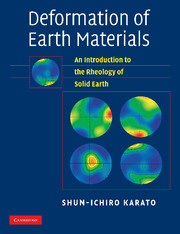Book contents
- Frontmatter
- Contents
- Preface
- Part I General background
- Part II Materials science of deformation
- 4 Elasticity
- 5 Crystalline defects
- 6 Experimental techniques for study of plastic deformation
- 7 Brittle deformation, brittle–plastic and brittle–ductile transition
- 8 Diffusion and diffusional creep
- 9 Dislocation creep
- 10 Effects of pressure and water
- 11 Physical mechanisms of seismic wave attenuation
- 12 Deformation of multi-phase materials
- 13 Grain size
- 14 Lattice-preferred orientation
- 15 Effects of phase transformations
- 16 Stability and localization of deformation
- Part III Geological and geophysical applications
- References
- Materials index
- Subject index
- Plate section
8 - Diffusion and diffusional creep
Published online by Cambridge University Press: 05 June 2012
- Frontmatter
- Contents
- Preface
- Part I General background
- Part II Materials science of deformation
- 4 Elasticity
- 5 Crystalline defects
- 6 Experimental techniques for study of plastic deformation
- 7 Brittle deformation, brittle–plastic and brittle–ductile transition
- 8 Diffusion and diffusional creep
- 9 Dislocation creep
- 10 Effects of pressure and water
- 11 Physical mechanisms of seismic wave attenuation
- 12 Deformation of multi-phase materials
- 13 Grain size
- 14 Lattice-preferred orientation
- 15 Effects of phase transformations
- 16 Stability and localization of deformation
- Part III Geological and geophysical applications
- References
- Materials index
- Subject index
- Plate section
Summary
Diffusional creep is an important mechanism of plastic deformation in a polycrystalline material at relatively low stress and small grain size. There is evidence that diffusional creep plays an important role in some regions of Earth. At high temperatures, atoms move from their stable positions with some probability due to thermally activated processes. This is referred to as diffusion. The driving force for diffusion is the gradient in chemical potential including the concentration gradient caused by the contact of materials with different chemical compositions or by the stress gradient at grain boundaries created by the applied stress. Consequently, the rate of deformation due to diffusive mass transport is sensitive to diffusion coefficient as well as grain size: the rate of deformation is faster for a smaller grain size. Similar to other processes, diffusional mass transport involves a number of parallel (independent) and sequential (dependent) processes. As a result, the interplay of various diffusing species can be complicated and this also results in a complicated variation in grain-size sensitivity with grain size. Deformation of a polycrystalline material is associated with grain boundary sliding. Large-strain plastic flow involving grain-boundary sliding is sometimes referred to as superplastic flow. Materials science models of superplastic flow are reviewed and some geological significance is discussed. Finally, transient diffusional creep caused by the stress redistribution and its possible roles in small-strain deformation in Earth are discussed.
Key words point defects, diffusion, Fick's law, high-diffusivity path, chemical reaction, Nabarro–Herring creep, Coble creep, pressure-solution creep, grain-boundary sliding, superplasticity.
- Type
- Chapter
- Information
- Deformation of Earth MaterialsAn Introduction to the Rheology of Solid Earth, pp. 123 - 142Publisher: Cambridge University PressPrint publication year: 2008



